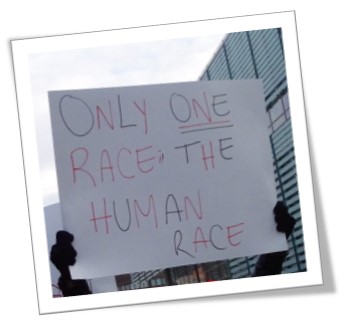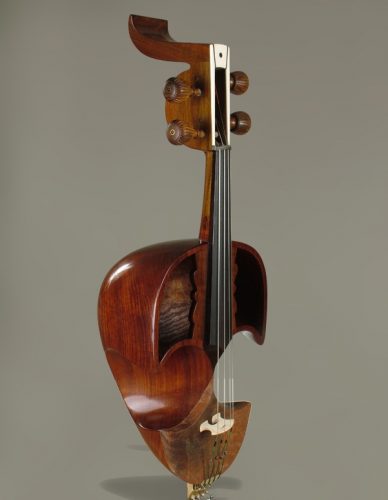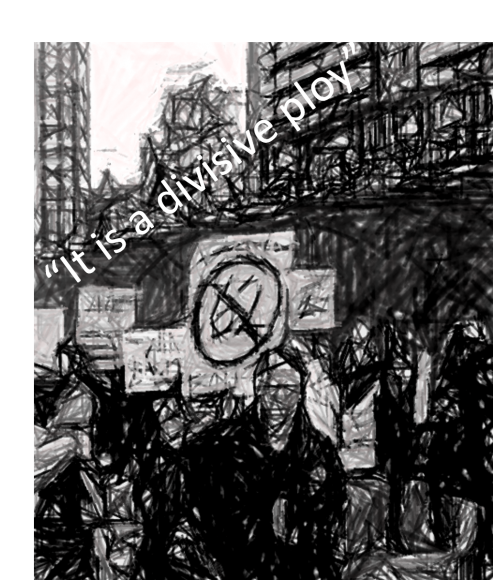As we observe that the multitudes of heritages operate in competition with each other (“mine is bigger than yours…”), we find that ramifications of this scramble for influence pervade a multitude of cultural, political and economic spheres. In what follows, I’ve jotted down ruminations regarding some of them.
- Language: “my language is bigger than your dialect”
When studying languages and dialects (as I have been doing now for several decades), one quickly becomes aware of a fundamental fact: despite widespread conceptions to the contrary, there are no superior or inferior languages. We only need to look at the prestige of the classical languages, in particular Latin. When I decided in 7th grade high school to enrol in French rather than Latin, my mother huffed contemptuously, insisting that knowledge of Latin was the best foundation for all other languages. I suppose what she meant was that learning Latin gave you a firm grasp on grammar, teaching you grammatical concepts such as case, aspect, modality, etc. But many other living languages can do that also, including German, with its four different cases. (Growing up in Germany, I had already learned about the concept of case in primary school).
This obsession about Latin (widespread in my family to the present day, as in many other families) is really an obsession with cultural prestige: educated people should know Latin. (Why? Wouldn’t knowledge of living languages make cultural exchange and open-mindedness so much easier?) Furthermore, this obsession has cost speakers and writers of English dearly, as it is at the root of a number of nonsensical prescriptive grammar rules, such as “Don’t split an infinitive.” Why on earth not? (“Don’t say ‘to boldly go where no one has gone before’.”)
This “rule” can be traced back to precisely the obsession with classical languages. Here, the infinitival construction (as in many modern languages) was made up of the verb stem plus an infinitival word ending (a suffix). And since one cannot generally insert an adverb or some other word into a word, it is clear that in Latin, infinitives will never be split (and the same goes for Spanish, French, and German…). English, however, developed the to infinitive at some stage of its evolution, expressing the infinitive by a separate word to. Hence the possibility of a split infinitive construction. Language stigmas remain a social marker for those who wield power and privilege in a society.
We don’t need to look as far back as ancient Greek or classical Latin. In 1996, the Oakland School Board in California passed a resolution that recognized the dialect spoken by many African Americans as a legitimate linguistic system and thus a language, not a “mere” dialect.
The resolution had a very practical aim, namely to rectify systemic problems in the educational system that statistically disadvantaged African American students, by correctly putting its finger on a language issue: their home language was sufficiently different from the variety of English taught in schools to warrant the latter being taught as a second language. Furthermore, it determined that the teaching of Standard English should not lead to the eradication of Ebonics (as the Oakland School Board named the variety of English more commonly known by linguists as African American English or inner-city English).
In spite of having widespread support among linguists, the resolution created an uproar in the media, partly due to misconceptions and misunderstandings, and released a tsunami of slurs against this speech variety. The latter was frequently denigrated as “slang” or “bad/deficient grammar” despite the fact that linguistic research has long shown this language variety to be based on a systematic mental grammar as rich and coherent as that of any other variety of English.
Linguist Wayne O’Neil from MIT characterized the reaction as follows: “Why the outrage over the Oakland resolution from the media and from the politicians? In my own view it has to do with the fact that in the United States – as in many parts of the industrialized world – language prejudice remains a “legitimate” prejudice: that is, one can generally say the most appalling things about people’s speech without fear of correction or contradiction. The exercise of this prejudice in the United States is often, but not only, a shield for racism (and classism), thus allowing the holders of racist views a freedom no longer readily acceptable in civil society.” O’Neil also adroitly notes that the lower the social prestige and standing of a speech community in a society, the less valued their particular speech variety will be. (O’Neil 1998:42)
In other words, the prestige of a language or a dialect is defined purely in terms of economic power and socio-political considerations. The ramifications of these social classifications can be disastrous for children who happen to be born into a stigmatized language variety. (See Perry & Delpit, 1998.)
- Art: who gets funded?
Confined to my bed nursing a minor indisposition, I am privy to a concert rehearsal in the next room: a piano, a santur and a gheychak are vying for acoustic space. This is my initiation to the gheychak, an instrument I still have not seen, as my first experience of it is an aural perception through a wooden door. As I marvel at its beautiful, sandy and haunting sounds, I drift off to sleep, emerging intermittently from oneiric flurries. I awaken fully only when the rehearsal is breaking up. The next day repeats the experience, my cat and I happily self-imprisoned and cuddled together in a thick duvet, daydreaming and dozing through sequences of astonishing mixes of sounds and timbres.
A few days later, the concert takes place in a popular basement hangout in the Mile End that has an indistinct Greenwich Village feel. The music starts and – now experienced with all my senses awakened – is splendid. It is unusual not only in its timbral combination, but also in its indefinable genre, with features of jazz, of contemporary music, of electronica, and original arrangements of classical pieces. Imagine hearing an Indian raga played in a trio with a piano, or the airs of Erik Satie’s Gnossiennes with a gheychak. As the name of the series, Confluence, evokes, there is a flowing together of different traditions. It is a truly inclusive music – disenfranchised from the usual categories and ethnic labels.
The echo of the santur and the gheychak still haunting my mind, the following week I attend a conference at Université de Montréal entitled La musique, reflet de notre société? Interesting talks by three invitees. The first speaker ends with something to the effect that if you want to learn about Russian society of the 20th century, listen to Shostakovich; if you want to learn about Tibetan society listen to… and so on. During question period I ask: ‘If you want to know about our Québécois contemporary society, what do you listen to?’ My question, as I explain, addresses the fact that we listened to an hour of talks on music and our society, and not once was any reference made to the considerable cultural diversity of our society. In fact, it was all about Eurocentric music: la musique sérieuse is apparently limited to music based on Occidental traditions.
My question, still essentially unanswered, is later echoed by another member of the audience who brings up the crucial aspect of power, privilege and funding: “Who decides which music is taught in music departments? Who decides which projects are funded by art councils? Who has the power, and who gets the money?” So here is the (trivial) question: is the “bigger” your musical (cultural) heritage, the bigger the budget you may tap into?
And while there have been efforts to acknowledge cultures not rooted in Europe, with special programs and grants reserved for art and music from other parts of the world, not all musicians are interested in being relegated to the category of world music or parcelled up and typecast as producing “ethnic” music.
Where does this leave music that is not riding on a particular identity or genre?
- Laïcité and religion: I’ll keep my cross but you take off your turban
I overhear a conversation at a dinner gathering: one person reports that in Montréal, the mosques are all full to the brim while the churches are all empty. An argument instantly breaks out. “How do you know this? When have you been to a mosque?’” “Everyone knows this, It’s obvious,” and so on. Without getting involved, I say to myself, “Of course the churches are empty, silly. Montréal is the city of a thousand churches and they have all been deserted since the Révolution tranquille. Mosques, on the other hand, have presumably been built on an on-demand basis in recent decades.”
Rethinking the conversation later, I am struck by another question: Why does it matter? Let’s say it is true. Who cares? Why should we care? Why should it bother anyone whether non-Christian religions are building and filling mosques or synagogues or temples? Yes, the Québécois suffered immensely under the rule of the Catholic Church for centuries before liberating themselves not only from their English oppressors but also from the Church, in one fell swoop. But why should Muslims praying in mosques in large numbers bother anyone? It is not like there is any danger that the Muslim religion will overcome them and force them back to piety. The irrational fear of “the Other” is indeed most pronounced when it comes to Muslims. This way of stereotyping also glosses over the fact that not all Muslims are practising; there are secular Muslims, just as there are secular Jews and Christians.
In the wake of the controversy around Loi 62 last year, I did an informal survey in the writing class I was teaching, asking students how many Muslims they thought lived in Québec. As I expected, the percentages were grossly overestimated (between 20% and 10% of the population). As a matter of fact, Muslims account for fewer than 2% of the Québec population, although the percentage rises to over 9% in the Greater Montréal region. How many wear a niqab, or a burqa? First, only half of Québec Muslims are women, and only a tiny percentage of them cover their faces. The number of women who might be covering up entirely has been estimated at less than 50 to at most 100!
Loi 62, proposed by Québec’s Liberal government, just like its cousin La charte des valeurs proposed by the Parti Québécois a few years earlier, has nothing to do with religious neutrality and everything to do with political strategy. It is a divisive ploy under the cover of laïcité that has done more harm than good to the unity of people living in Québec. (As in other areas, Québec is copying the follies of its European French colonial roots only too willingly.) It is also very transparently an electoral ploy: the polls tell us that over 90% of Francophones and over 60% of Anglophones support Loi 62, which would restrict these few women from receiving public services. Politicians anxious for voters are thus ruthlessly exploiting widespread prejudices among the population, while at the same time exacerbating divisive tendencies.
- Wars (i)
I recently revisited the magnificent novel Cassandra, written in the early ‘80s by East German author Christa Wolf. In it, Wolf does something quite extraordinary: she retells the myth of Cassandra and the Trojan War by giving the narrator’s voice, in stream-of-consciousness, to Cassandra herself. In Wolf’s Cassandra, the Trojan War was first and foremost about control over the Hellespont (commonly known as the Dardanelles). The story of Paris and the beautiful Helen are recast as a mere cover used in order to stir up warmongering. Cassandra recounts in great detail the changes to Trojan society in preparation of the war: the increasing patriarchal constellation excluding women from decision-making processes, the stirring up of hatred against the Achaean people, the gradual dissolution of rational thought and argument, and crucially, the increasing emphasis on state security (Eumelos’ police state).
Cassandra herself is portrayed as a person who dares to question these developments and the loss of sense and meaning in society as a whole, and who has the courage to see what is obvious and state it. For that she is persecuted and cast out, settling among women of marginalized ethnicities, with whom she ends up feeling happier than inside the city walls and the palace of Troy. Wolf manages to write about an ancient myth, one of the oldest literary works of Europe, in terms that are more lucid than most mainstream representations of contemporary wars. In other words, she attempts to undermine a popular mythic belief, and may well underscore the contrary perspective.
- Wars (ii)
Yes … plus ça change plus c’est la même chose. Needless to repeat here that the Iraq war had nothing to do with liberating the Iraqi people from a brutal dictator with weapons of mass destruction, nor did the lasting Afghanistan invasion (the “good war”) have anything to do with liberating women from the Taliban, but was all about geopolitical control. And what to make of the warmongering toward Russia and Iran? A population must be well prepared – manipulated through demeaning stories and images, fear mongering, and ethnic alienation – before it will accept its leaders’ warmongering and warfaring that is so destructive to its own society, in terms of security, economy, ethics, etc. Whence the very pragmatic function of the profound Islamophobia in Western societies: to ensure the population’s acquiescence toward decades-long wars against Muslim countries.
- Multiculturalism and diversity
Let us return to Québec, which is an interesting example regarding the question of heritage. As Charles Taylor (2010) argues, multiculturalism, which Canada has made its societal trademark, eschewing any other distinct cultural identity for itself, is understandably ill-suited for Québec with its existential need to protect its francophone identity. In other words, Québec cannot abstain from its particular cultural heritage in a way that the rest of Canada can. For this reason, Québec favours interculturalism and integration. But this differently framed model (mostly differing in terms of framing, according to Taylor, op. cit.) should not lead to the kind of ethnic cultural protectionism that we so often encounter here. The perception of diversity as a threat to the French language (protected by existing laws) and to Québécois cultural heritage is sad, and often becomes ugly. In a disturbing Le Devoir article, Christian Rioux compares diversity to a fish counter at the supermarket that mainly offers exotic but low-quality imported fish and only rarely has local varieties. This is hardly an isolated rant, but the evoked smell of none-too-fresh fish did make it stick out.
In Québec’s Charte des valeurs and its cousin Loi 62, the size of heritage comes out neatly: take off your hijabs, kippahs and turbans (if you want jobs), but our big cross on the mountain and the smaller one in the National Assembly stay put; they are not religious symbols, but purveyors of our (“big”) cultural heritage.
- Identity politics versus class struggle
Evoking a cultural or religiously distinct enemy is not restricted to external wars, but is equally of importance internally as a way to subdue the masses – the so-called 99% – before the thieving 1%. Ideally, frustrations are redirected toward the Other, scapegoating immigrants, refugees and underprivileged visible minorities by right-wing demagogues. Non-rightwingers are more nuanced about it: certain members of visible minorities are admitted into top circles, provided they take on the modus operandi of the existing elite. The others are accepted as “minorities,” honoured in rhetoric only. (Remember Hillary Clinton’s reference to certain Black youth as “superpredators,” while her husband ensured that the private industrial prison complex would prosper with a steady population drawn overwhelmingly from African Americans? Remember Obama’s acting as “deporter in chief?” Often the liberals get much of the “dirty work” of the conservatives done with no or little resistance, since they manage to couch it in “nicer” terms.)
Identity politics itself has been manipulated in terms of separating identities and causes – divide and conquer applies everywhere. So while the rightwing approach involves overt scapegoating, the liberal approach is to superficially grace various identities (LBGTQ, women, Blacks…) while preventing genuine class struggle from occurring. For the privileged class, the idea is to maintain their privilege for themselves. For the disenfranchised of the dominant class (i.e., the white working class), the idea is to find a scapegoat.
So, returning to the theme of this issue, the calculation of the size of one’s heritage is directly correlated to the proportion of power and privilege one enjoys in society.
References
O’Neil, Wayne. 1998. If Ebonics Isn’t a Language, Then Tell Me, What Is? In The Real Ebonics Debate: Power, Language, and the Education of African-American children, T. Perry & L. Delpit (eds) Boston: Beacon Press, pp. 38-48. Accessible via http://rethinkingschools.aidcvt.com/publication/ebonics/eboneil.shtml
Perry, Theresa and Lisa Delpit (eds.) 1998. The Real Ebonics Debate: Power, Language, and the Education of African-American children. Boston: Beacon Press.
Rioux, Christian. 2017. La «diversité» ou la tarte à la crème. Le Devoir, 13 janvier 2017. URL: https://www.ledevoir.com/opinion/chroniques/489133/la-diversite-ou-la-tarte-a-la-creme
Taylor, Charles. (2012) Interculturalism or multiculturalism? Philosophy and Social Criticism 38(4-5), pp. 413–423.











